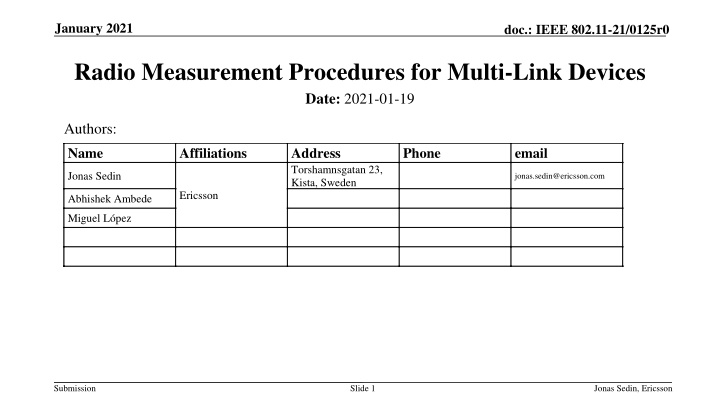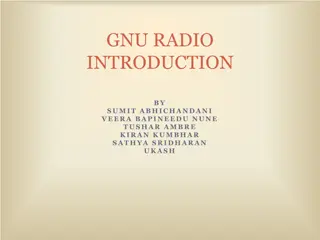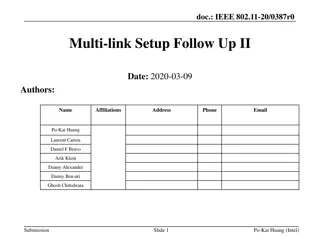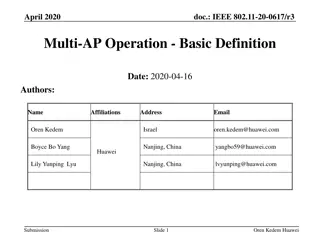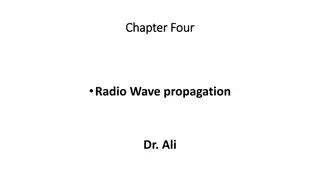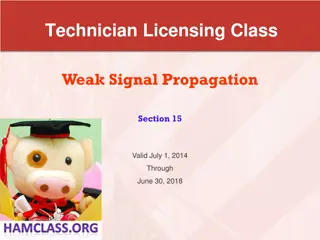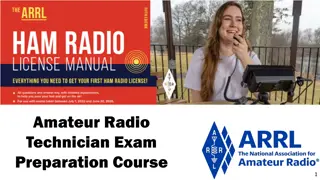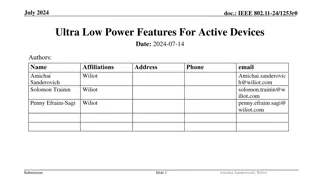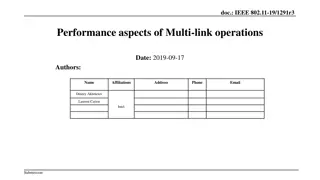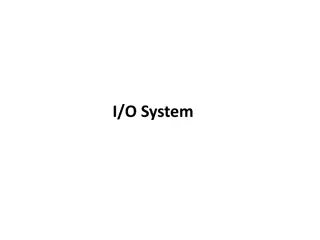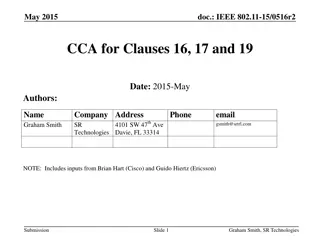IEEE 802.11-21/0125r0 Radio Measurement Procedures for Multi-Link Devices
The IEEE 802.11 WLAN standard introduces the concept of Multi-Link Devices (MLD) in the 802.11be (EHT) amendment, enabling multiple affiliated STAs to work together. This document focuses on enhancing radio measurement procedures for MLDs to boost efficiency and flexibility in managing radio resources across these devices. Challenges, background information, and the need for improved procedures for MLDs are discussed.
Uploaded on Sep 16, 2024 | 0 Views
Download Presentation

Please find below an Image/Link to download the presentation.
The content on the website is provided AS IS for your information and personal use only. It may not be sold, licensed, or shared on other websites without obtaining consent from the author.If you encounter any issues during the download, it is possible that the publisher has removed the file from their server.
You are allowed to download the files provided on this website for personal or commercial use, subject to the condition that they are used lawfully. All files are the property of their respective owners.
The content on the website is provided AS IS for your information and personal use only. It may not be sold, licensed, or shared on other websites without obtaining consent from the author.
E N D
Presentation Transcript
January 2021 doc.: IEEE 802.11-21/0125r0 Radio Measurement Procedures for Multi-Link Devices Date: 2021-01-19 Authors: Name Affiliations Address Torshamnsgatan 23, Kista, Sweden Phone email Jonas Sedin jonas.sedin@ericsson.com Ericsson Abhishek Ambede Miguel L pez Submission Slide 1 Jonas Sedin, Ericsson
January 2021 doc.: IEEE 802.11-21/0125r0 Abstract The IEEE 802.11 WLAN standard supports diverse radio measurements. In the 802.11be (EHT) amendment, the concept of a multi-link device (MLD) comprising multiple affiliated STAs is a key new feature [2]. Depending upon the functions, the EHT amendment supports MLD-level management functionality as well as STA-level (i.e., link level) management functionality [2, 3, 4]. When the measurement requesting and reporting devices are MLDs, there is scope to enhance the radio measurement procedures to achieve improved overall efficiency and flexibility. Submission Slide 2 Jonas Sedin, Ericsson
January 2021 doc.: IEEE 802.11-21/0125r0 Background Multi-Link is a key new feature in EHT [2] A logical entity termed as a multi-link device (MLD) has multiple STAs affiliated with it. There is a single medium access control (MAC) service access point (SAP) to logical link control (LLC). For MLDs, some functions will be on an MLD-level [3] such as Security association/ state, Sequence number assignment. For MLDs, some functions are considered on a STA-level (i.e., link level) [3] such as Clear channel assessment, MPDU aggregation/ de-aggregation. The above mentioned split of functionality may not be always explicitly written in the standard. For an MLD, one may think of a split featuring an upper MAC comprising a single MLD-level address and a lower MAC comprising STA-level addresses. Submission Slide 3 Jonas Sedin, Ericsson
January 2021 doc.: IEEE 802.11-21/0125r0 Background IEEE 802.11 supports Radio Resource Management procedures [1], for example, to gain a better understanding of and potentially improve the operating conditions of STAs. It can help, for example, in load balancing or changing the channel to a less noisy one. The radio measurement procedures are defined as STA to STA procedures. Examples of measurement reports that can be requested: Beacon report Channel Load Report Noise Histogram Report STA statistics report Radio measurement procedures in the context of EHT, and especially for MLDs, have not yet been actively discussed in TGbe. Thus, it would be natural to assume that for MLDs, the radio measurement procedures are STA-level procedures. Submission Slide 4 Jonas Sedin, Ericsson
January 2021 doc.: IEEE 802.11-21/0125r0 Challenges As per current specifications, if applied to MLDs, the measurement procedures are on a STA-level. Even if the need for measurement reports is urgent, a STA might refuse any measurement request for various reasons, such as reduced quality of service, unacceptable power consumption, measurement scheduling conflicts. Measurements on operating and nonoperating channels [1]: Measurements on nonoperating channels might need the measuring STA to interrupt its data services on the operating channel, switch channels, and make measurements. Measurements on the operating channel might not require the STA to interrupt its data services. For MLDs, an MLD might have several affiliated STAs or available radios to perform measurements. If the radio measurement procedures are used for MLDs in the same way as they are currently defined, we may lose out on leveraging the multi-link capabilities of MLDs. Submission Slide 5 Jonas Sedin, Ericsson
January 2021 doc.: IEEE 802.11-21/0125r0 Challenges contd. In this contribution, we propose to clarify radio measurement procedures for MLDs, to enable 1. Requesting/reporting radio measurements over any link. 2. For any STA within an MLD to perform non-operating channel measurements, This brings the following benefits Flexibility that should be possible for MLDs, Reduced overhead when requesting/reporting measurements, Enabling multiple measurement requests for different STAs in an MLD to be sent at once, without having to send it to every STA. Multi-link measurement example Jonas Sedin, Ericsson Submission Slide 6
January 2021 doc.: IEEE 802.11-21/0125r0 Scenario 1 Requesting/Reporting Radio Measurements over any Link The text in 11.11 clearly prohibits several actions that would be beneficial and easy to do in MLDs: In Section 11.11.6 [1]: Measurement requests for radio measurements that the STA has advertised it is not capable of shall be rejected. In Section 11.11.6 [1]: Measurement Report elements shall be returned to the requesting STA in one or more Radio Measurement Report frames. In Section 11.11.9.1 to 11.11.9.6 [1]: If a STA accepts a request, it shall respond with a Radio Measurement Report frame. Furthermore, while several of the measurement request frames contain information about channel, bandwidth, and band, some do not: Basic Request, CCA Request, RPI Histogram request Thus, we suggest to Update spec text to clarify the above rules in the case of MLDs, and Update the radio measurement request frames wherever necessary. Jonas Sedin, Ericsson Submission Slide 7
January 2021 doc.: IEEE 802.11-21/0125r0 Scenario 2 Multi-Link Non-Operating Channel Measurements Non-operating channel measurements will typically cause interruptions of the data transmissions for a STA to move to another channel to perform measurements. The STA might therefore reject a non-operating channel measurement request due to reduced quality of service. These interruptions can be avoided if another STA in the same MLD is used for performing the requested measurement. The text in 11.11 may also prohibit this: In Section 11.11.5 [1]: A radio measurement-capable STA shall decode and interpret each Radio Measurement Request frame that it receives and shall assess the contents against its capabilities and the impact on its own performance. Thus, we suggest to Consider updating spec text to clarify what is allowed for non-operating channel measurements in case of MLDs. Jonas Sedin, Ericsson Submission Slide 8
January 2021 doc.: IEEE 802.11-21/0125r0 Benefits By allowing requesting/reporting over any link, it may be possible to reduce the latency for transmitting and receiving the report and request By combining the scenario 1 and 2 there are increased flexibility As an example: It is possible to for instance request that a STA performs measurements over all link simultaneously without requiring separate measurement requests on each link Submission Slide 9 Jonas Sedin, Ericsson
January 2021 doc.: IEEE 802.11-21/0125r0 Summary With the motivation to improve flexibility, reduce signalling overhead and enable faster measurement request/reporting, we identified two relevant issues for multi-link devices Requesting/reporting radio measurements over any link Multi-link non-operating channel measurements Submission Slide 10 Jonas Sedin, Ericsson
January 2021 doc.: IEEE 802.11-21/0125r0 Straw Poll 1 Do you agree that TGbe should work on enhancing the IEEE 802.11 radio measurement procedures to leverage multi-link devices? Yes No Abstain Submission Slide 11 Jonas Sedin, Ericsson
January 2021 doc.: IEEE 802.11-21/0125r0 Straw Poll 2 Do you agree to add the following to the SFD for R1: A STA affiliated with an MLD may request a responding MLD to perform radio measurement(s) using an affiliated STA different from the STA to which the measurement request was sent. Submission Slide 12 Jonas Sedin, Ericsson
January 2021 doc.: IEEE 802.11-21/0125r0 Straw Poll 3 Do you agree to add the following to the SFD for R1: 11be shall define support for MLDs requesting and reporting radio measurements over multiple links. If a measurement request is received on one link, the corresponding report may be sent over any other link. Submission Slide 13 Jonas Sedin, Ericsson
January 2021 doc.: IEEE 802.11-21/0125r0 References [1] IEEE Std 802.11-2016 , doi: 10.1109/IEEESTD.2016.7786995, Dec. 2016. [2] IEEE P802.11be/D0.2 , Dec. 2020. [3] 11-20-1639r07, 802.11be AP MLD Architecture Discussion , Dec. 2020. [4] 11-20-881r03, Multi-link Individual Addressed Management Frame Delivery , Oct. 2020. Submission Slide 14 Jonas Sedin, Ericsson
